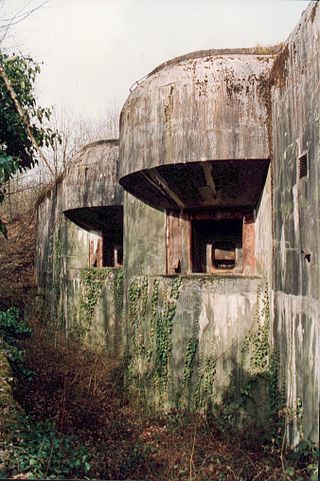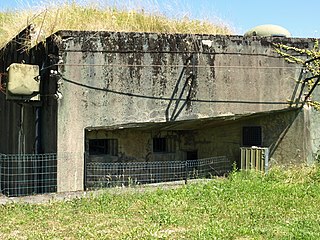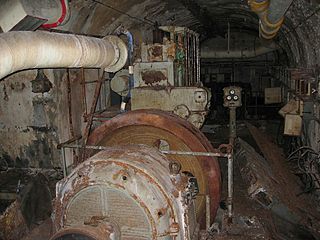
Ouvrage du Kobenbusch is a gros ouvrage of the Maginot Line, located in the Fortified Sector of Thionville in the Cattenom Forest. It possesses seven combat blocks and two entrance blocks, one for ammunition and the other for men. It is located between petit ouvrage Bois-Karre and petit ouvrage Oberheid, and was named for the surrounding Kobenbusch Forest.
Ouvrage Bovenberg is a lesser work of the Maginot Line. Located in the Fortified Sector of Boulay, the ouvrage is located between petits ouvrages Berenbach and Denting, facing Germany. It consists of two infantry blocks and two artillery blocks.
Ouvrage Village Coume is a lesser work of the Maginot Line. Located in the Fortified Sector of Boulay, the ouvrage consists of three infantry blocks, and is located between petits ouvrages Bovenberg and Coume Annexe Nord, facing Germany. The position saw little action in World War II. It was sold in the 1970s and stripped by salvagers.
Ouvrage Coume is a lesser work of the Maginot Line. Located in the Fortified Sector of Boulay, the ouvrage consists of two infantry blocks, and was located between petits ouvrages Coume Annexe Nord and Coume Annexe Sud, facing Germany.

Ouvrage Billig, a gros ouvrage or large fortification of the Maginot Line, was located in the Fortified Sector of Thionville, Moselle in northern France. It is located between the gros ouvrages Metrich and Hackenberg, facing Germany. It saw relatively little action during World War II and after a period of reserve duty in the 1950s, was abandoned in the 1970s.

Ouvrage Sentzich is part of the Fortified Sector of Thionville of the Maginot Line. The petit ouvrage for infantry is located to the south of gros ouvrage Galgenberg, on the edge of the main road to Luxembourg near the village of Sentzich. Gros ouvrage Métrich is to the east. As a small work, it was not considered for use after World War II and was abandoned. It is secured and is not open to the public.

Ouvrage Immerhof, also known as Ouvrage Ferme-Immerhof, is one of the largest petit ouvrages of the Maginot Line of north-east, France. Located near the community of Hettange-Grande, it is 7 km north of Thionville between the gros ouvrages of Molvange and Soetrich, the closest ouvrage to the Luxembourg frontier. It was part of the Fortified Sector of Thionville, in the Fortified Region of Metz, the strongest portion of the Line. Apart from its function as a communication post between the neighbouring gros ouvrages, Immerhof also controlled the road and railway routes from Luxembourg, which pass in the immediate vicinity. In addition, Immerhof protected other Maginot works in the vicinity: the casemates of Kanfen, the infantry shelter of Stressling, the observation point and shelter of Hettange-Grande, and a number of nearby blockhouses constructed during the Phoney War.

Ouvrage Soetrich is a gros ouvrage of the Maginot Line in north-eastern France. Soetrich is located between petits ouvrages Immerhof and Bois Karre, facing the France-Luxembourg border near the town of Hettange-Grande, part of the Fortified Sector of Thionville. Compared with other gros ouvrages, Soetrich is compact in arrangement, with the entries and underground ammunition magazines and barracks in close proximity to the combat blocks, accessed through underground galleries at an average depth of 30 metres (98 ft). Its primary purpose was to cover the main road to Luxembourg, just to the west. Along with its neighbours, Ouvrage Rochonvillers and Ouvrage Molvange, Soetrich was used during the Cold War as a secure command centre for NATO forces.

Ouvrage Bois- Karre is located in the Fortified Sector of Thionville of the Maginot Line, facing the France - Luxembourg border. The petit ouvrage is situated in the Cattenom Forest between the gros ouvrages Soetrich and Kobenbusch, just south of Boust. It is unusual for a Maginot fortification in its construction as a single blockhouse, with no underground gallery system or remotely located entries. Bois-Karre has been preserved and is maintained as a museum.

Ouvrage Galgenberg forms a portion of the Fortified Sector of Thionville of the Maginot Line. It is situated in the Cattenom Forest, near the gros ouvrage Kobenbusch and petit ouvrage Oberheid. The ouvrage was tasked with controlling the Moselle Valley and as such was called the "Guardian of the Moselle." Galgenberg did not see significant action in 1940 or 1944. After a period of reserve duty in the 1950s and 1960s, it was deactivated. It is now a museum.

Ouvrage La Salmagne is a petit ouvrage of the Maginot Line, built as part of the "New Fronts" program to address shortcomings in the Line's coverage of the border with Belgium. Like the other three ouvrages near Maubeuge, it is built on an old Séré de Rivières system fortification, near the town of Bersillies. The Ouvrage Bersillies is nearby to the northwest. La Salmagne has been preserved and is open to the public.
Ouvrage Bersillies is a petit ouvrage of the Maginot Line, built as part of the "New Fronts" program to address shortcomings in the Line's coverage of the border with Belgium. Like the other three ouvrages near Maubeuge, it is built on an old Séré de Rivières-system fortification, near the town of Bersillies. The preserved Ouvrage La Salmagne is nearby to the southeast. Bersillies is not open to the public.

Ouvrage Les Aittes is a lesser work of the Maginot Line's Alpine extension, the Alpine Line. The ouvrage consists of one entry block, three infantry blocks and one observation block, about two kilometers east of Cervières, Hautes-Alpes at an altitude of 2,029 metres (6,657 ft)..

Ouvrage Col de Crous is a lesser work of the Maginot Line's Alpine extension, the Alpine Line. The ouvrage consists of one infantry block at an altitude of 1,963 metres (6,440 ft). Additional blocks were planned but not built.
Ouvrage Valdeblore is a lesser work of the Maginot Line's Alpine extension, the Alpine Line. The ouvrage consists of one entry block, one infantry artillery block and one observation block at an altitude of 842 metres (2,762 ft). Valdeblore was built starting in November 1930 by Poiljeux contractors, and was completed by Thorrand et Cie in April 1933 at a cost of 1.6 million francs.
Ouvrage La Séréna is a lesser work of the Maginot Line's Alpine extension, the Alpine Line. The ouvrage consists of one entry block at an altitude of 1,292 metres (4,239 ft). Two more blocks were planned but not completed before the invasion of France in 1940.
Ouvrage Col du Fort is a lesser work of the Maginot Line's Alpine extension, the Alpine Line. The ouvrage consists of one infantry block and one observation block at an elevation of 1,717 metres (5,633 ft). An additional block was planned but not built.
Ouvrage La Déa, also known as the Petit Ouvrage de la baisse de la Déa, is a lesser work of the Maginot Line's Alpine extension, the Alpine Line. The ouvrage consists of two entry blocks and one observation block facing Italy at an altitude of 1,777 metres (5,830 ft), armed with one observation cloche and one machine gun embrasure. The ouvrage was manned by 81 soldiers in 1940, and commanded by sous-lieutenant Guillemin. The position was sited to control the Maglia valley. A fourth block with three machine gun positions was not built.
Ouvrage Vélosnes is a gros ouvrage of the Maginot Line, located in the Fortified Sector of Montmédy between the towns of Othe and Vélosnes, facing Belgium. It possesses four combat blocks and one entrance block. It is located to the east of petit ouvrage Thonnelle. The position was sabotaged and abandoned by French forces that were ordered to retreat from the exposed position in June 1940 during the Battle of France. The ouvrage is abandoned and is administered as a nature preserve.

Ouvrage Thonnelle is a petit ouvrage of the Maginot Line, located in the Fortified Sector of Montmédy between the towns of Thonnelle and Verneuil-Petit, facing Belgium. It possesses four combat blocks. It is located between gros ouvrages Vélosnes and Chesnois. The position was sabotaged and abandoned by French forces that were ordered to retreat from the exposed position in June 1940 during the Battle of France. The ouvrage is abandoned.












